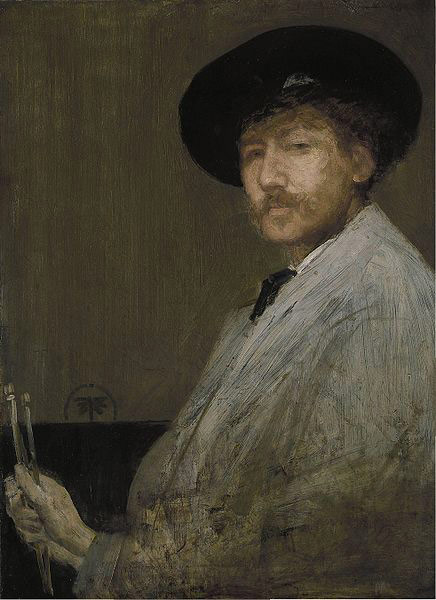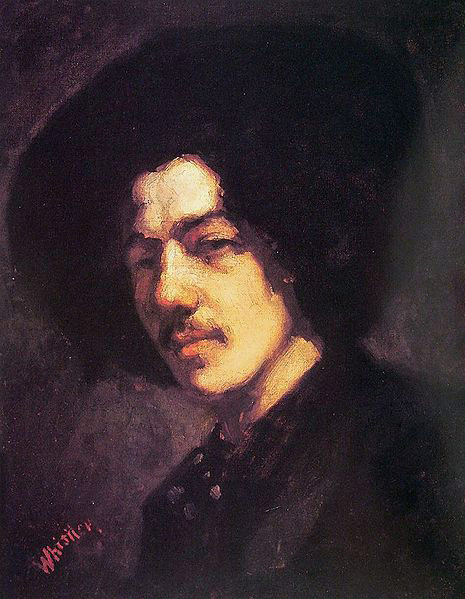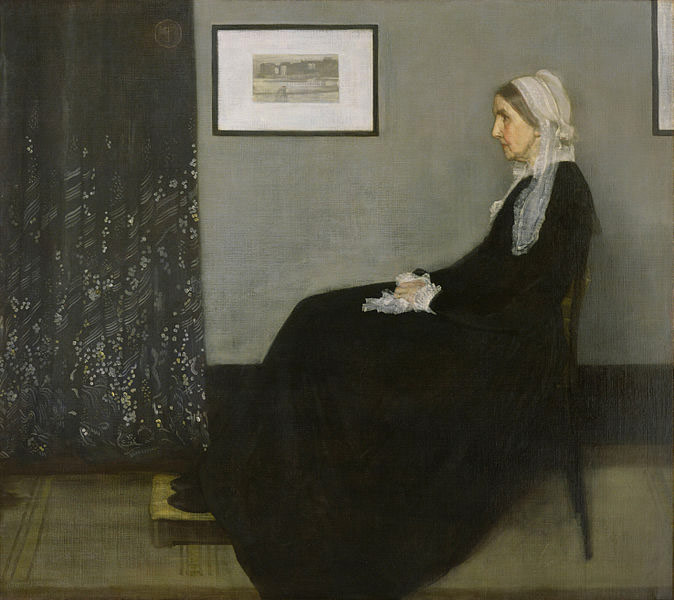| James McNeill Whistler | |
|---|---|
 |
|
| Born | July 11, 1834 Lowell, Massachusetts, U.S. |
| Died | July 17, 1903 (at age 69) London, England, UK |
| Nationality | American |
| Education | United States Military Academy, West Point, New York |
| Movement | Founder of Tonalism |
| Field | Painting |
| Works | View Complete Works |
James Abbott McNeill Whistler was born on 10 July, 1834 in Massachusetts. He was the third son of George Whistler, a civil engineer, and his second wife Anna McNeill. The American born graphic artist, spent his early life in Russia, following the move of his family to Russia where his father worked as a civil engineer. By then, James Whistler was only 9 years and studied drawing at the Imperial Academy of Science. In 1848, James went to live with his sister and her husband in London. Following the death of his father in 1849, Whistler’s family reunited back in America and settled in Connecticut.
In 1851, Whistler moved to West Point and enrolled in the United Military Academy where he performed well in drawing class. Later, he was expelled from the school for deficiency in chemistry. Afterward he worked briefly for Winans Locomotive Works, and then at the drawing department of the United State Coast and Geodetic Survey. He decided to become a full time artist and moved permanently to Europe.
Early Career
 James returned to Europe, specifically arrived in Paris, France in 1855, where he rented a cottage in the Latin Quarter. While at Paris, he met his girlfriend Héloise, and studied traditional art for a brief period. The first two years were a bit difficult for him, although he was helped by a rich friend to stabilize his financial situation which was getting worse. In the summer of 1858, conditions got better, and Whistler traveled throughout France and the Rhineland with a fellow artist called Ernest Delannoy. Later on, with the assistance of French printer Auguste, James Whistler created a collection of etchings called The French Set. It was during that same year that this artist did his first ever self-portrait called Portrait of Whistler with Hat. Whistler’s first displayed work La Mere Gerard was also painted in 1858. This painting was followed by At The Piano, in 1859 in London.
James returned to Europe, specifically arrived in Paris, France in 1855, where he rented a cottage in the Latin Quarter. While at Paris, he met his girlfriend Héloise, and studied traditional art for a brief period. The first two years were a bit difficult for him, although he was helped by a rich friend to stabilize his financial situation which was getting worse. In the summer of 1858, conditions got better, and Whistler traveled throughout France and the Rhineland with a fellow artist called Ernest Delannoy. Later on, with the assistance of French printer Auguste, James Whistler created a collection of etchings called The French Set. It was during that same year that this artist did his first ever self-portrait called Portrait of Whistler with Hat. Whistler’s first displayed work La Mere Gerard was also painted in 1858. This painting was followed by At The Piano, in 1859 in London.
He adopted London as his home, although he continued paying regular visits to his friends in France. After spending a year in London, Whistler created another set of etching known as Thames Set, and some early imprecise work. He returned to Paris in 1861 for a while, where he produced his first eminent work known as Symphony in White, No. 1: The White Girl. This work was rejected for exposition at the conservative Royal Academy, although it was publicized in a private gallery using the title called The Woman in White. The painting was later revealed at the Salon des Refuses in 1863 in Paris. After two years, he painted an additional portrait of Hiffernan in white and entitled it The Little White Girl. Hiffernan was Whistler’s business manager and mistress. In 1864, he also completed two paintings: The Golden Screen and Lady of the Land Lijsen.
Other Famous Works
Nocturnal paintings: Whistler visited Chile in 1866, where he produced his first three nocturnes. Initially, he called them “moonlights” but later re-titled them to Nocturnes. Later on, he moved back to London and painted more nocturnes during the next 10 years. In 1872, he credited Frederick Leyland, his patron, for his inspirational music titles. In the same year, James painted yet another self-portrait and entitled it Arrangement in Gray: Portrait of the Painter. Furthermore, he started to re-title some of his previous works using musical terms such as symphony, study, nocturne, or arrangement. The nocturnes were one of whistler’s inventive works. Through the submission of some of his nocturnes to Paul Durand-Ruel, an art dealer, Whistler got the chance to give details of his evolving theory in art to buyers, critics, and other artists in France.
 Portraits: During Franco-Prussian War in 1870, many artists retreated to England, joining James Whistler. Some of these artists included Monet and Pissarro. In 1871, James started to do portraits again, and immediately produce his famous painting titled Arrangement in Gray and Black No. 1. This painting is often incorrectly referred as Whistler’s Mother. This painting ignited varying reactions such as, ridicule, reverence and parody. This painting was later bought by the French government, making it the first work by Whistler in a public collection.
Portraits: During Franco-Prussian War in 1870, many artists retreated to England, joining James Whistler. Some of these artists included Monet and Pissarro. In 1871, James started to do portraits again, and immediately produce his famous painting titled Arrangement in Gray and Black No. 1. This painting is often incorrectly referred as Whistler’s Mother. This painting ignited varying reactions such as, ridicule, reverence and parody. This painting was later bought by the French government, making it the first work by Whistler in a public collection.
Other popular portraits by James Whistler include the ones of Maud Franklin in 1876, Theodore Duret in 1884, Cicely Alexander in 1873, Thomas Carlyle in 1873, and Lady Meux in 1882. The Peacock Room which was done in 1877 for Leyland exerted a powerful influence on the Aesthetic movement’s interior design.
In late 1880’s and early 1890s whistler gained popularity as an artist of international importance. He received many awards at exhibitions, some of his paintings were acquired by public collections, and most importantly he was elected in prestigious professional associations, including the Royal Academy of Fine Arts , Munich. The climax was in 1898 when he was elected as the International Society of Sculptors, Gravers, and Painters’ first president.
Marriage Life
James McNeill Whistler got married to Beatrix Godwin in 1888. Beatrix was the widow of E.W. Godwin, with whom James Whistler had collaborated with. Beatrix died of cancer in 1896, eight years after getting married to Whistler. Beatrix , posed for many of James Whistler’s drawings and paintings with her sisters Birnie and Rosalind. From the time of death of his wife, Whistler withdrew from social life. Whistler had a few illegitimate children, with Charles Hanson being the best documented one.
Honors and Legacy
James Whistler got many awards and also achieved worldwide recognition in his lifetime. Some of the honors he received include: in 1884, he was designated an honorary affiliate of the Royal Academy of Fine Arts; in 1892, he was made a Legion d’honneur’s officer; and in 1898, he became the first president of International Society of Sculptors, Painters, and Gravers. Some of his legacies include the house where he was born, which is currently preserved as Whistler House Museum of Art and series of etchings among others.
Death
After the death of his wife, Whistler was devastated and travelled constantly. It was in 1902 when he was in Holland that he got sick. Later in 1903, while in Chelsea England, James McNeill Whistler died of heart disease and was buried in St. Nicholas Church in Chiswick.